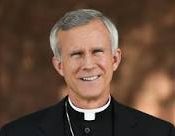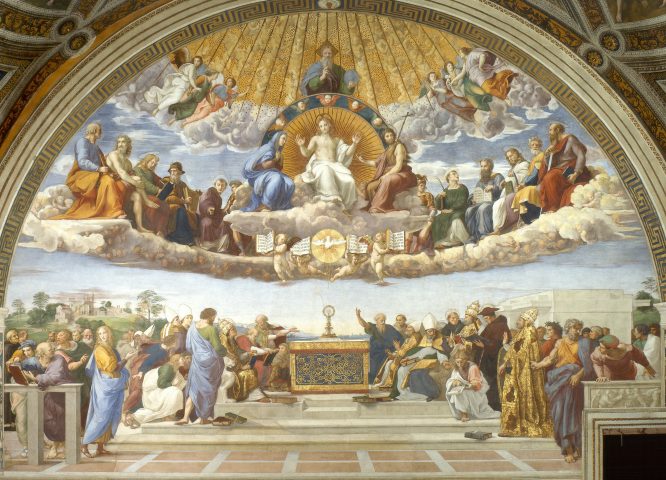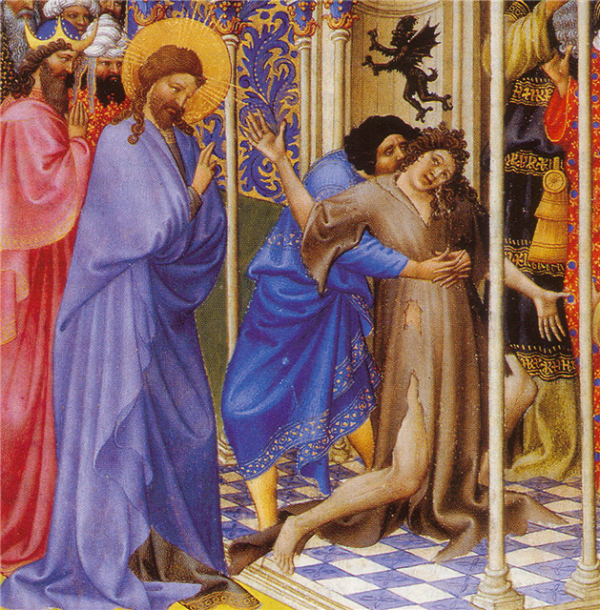West Warwick Priest Denies Communion for Lawmakers Who Supported Abortion Bill, Danielle Kennedy
February 10, 2020Daily Reading & Meditation: Tuesday (February 11)
February 11, 2020
By Most Rev. Joseph Strickland, The Wanderer, February 10, 2020
(Republished with permission of Mr. Joe Matt, The Wanderer)
 As we continue our series on Guarding the Deposit of Faith, we have been examining the great gift of the sacraments of the Catholic Church, through which Jesus Christ continues His ministry, in and through ordained ministers of His Mystical Body, the Church.
As we continue our series on Guarding the Deposit of Faith, we have been examining the great gift of the sacraments of the Catholic Church, through which Jesus Christ continues His ministry, in and through ordained ministers of His Mystical Body, the Church.
The Catechism of the Catholic Church explains, “The sacraments are efficacious signs of grace, instituted by Christ and entrusted to the Church, by which divine life is dispensed to us” (CCC, n. 1131). This simple but powerful statement should shake us to the bone, and draw us to our knees in prayer and gratitude. Jesus Christ is not dead. He is alive. And, He is ministering to us in every sacrament of His Church. He dispenses His Divine Life to us, through them!
In his second letter to the early Christians, the Apostle Peter wrote this introduction: “His divine power has granted to us all things that pertain to life and godliness, through the knowledge of him who called us to his own glory and excellence, by which he has granted to us his precious and very great promises, that through these you may escape from the corruption that is in the world because of passion, and become partakers of the divine nature” (2 Peter 1:3,4).
In and through our well-disposed reception of the sacraments, we actually become “partakers of the divine nature.” Our human nature is being transformed by His Divine Life, as we cooperate with grace. Through the grace received in and through the sacraments, we are invited into an ever deepening communion with the Lord, and, in Him, with one another, for the sake of the world.
The Catechism states: “Two other sacraments, Holy Orders and Matrimony, are directed toward the salvation of others; if they contribute as well to personal salvation, it is through service to others that they do so. They confer a particular mission in the Church and serve to build up the People of God” (CCC, n. 1534).
Notice, the Catechism links the two because they are both at the service of communion and mission. Lets briefly consider both.
Holy Orders
On November 28, 2012, His Eminence Daniel Cardinal DiNardo ordained me as the fourth Catholic bishop of Tyler, Texas. During the Rite of Ordination, he asked me several questions, two of those questions constantly remind me of my mission as a bishop.
First, “Are you resolved to be faithful and constant in proclaiming the Gospel of Christ?” and second, “Are you resolved to maintain the Deposit of Faith, entire and incorrupt, as handed down by the apostles and professed by the Church everywhere and at all times?”
My response to both questions was a resounding “I am!” It was at this point that the deeper meaning of the phrase “Deposit of Faith” came alive for me. I also began to understand my role in magisterial teaching and my serious call, as a successor of the apostles, to the ongoing task of “Guarding the Deposit of Faith” given by the Lord Jesus Christ Himself to the apostles and handed down since then.
My ordination as a bishop of the One, Holy, Catholic and Apostolic Church gave me an obligation which draws me to my knees in prayer every time I reflect upon it. I had already been ordained, first as a transitional deacon on December 8, 1984. Then, as a priest on June 1, 1985.
But, now, as a bishop, not only do I retain those other two orders, but I have been given the fullness of orders. I am responsible for my brothers who are priests and deacons. They have been placed, by virtue of my ordination, under my fatherly, pastoral care.
As the Catechism explains: “The bishop receives the fullness of the sacrament of Holy Orders, which integrates him into the episcopal college and makes him the visible head of the particular Church entrusted to him. As successors of the apostles and members of the college, the bishops share in the apostolic responsibility and mission of the whole Church under the authority of the Pope, successor of St. Peter” (CCC, n. 1594).
In exercising the office of bishop entrusted to me by the Lord I am regularly reminded, by the Holy Spirit, of these sobering words of Jesus Christ, the High Priest, “Everyone to whom much is given, of him will much be required” (Luke 12:48).
The Catechism explains: “Holy Orders is the sacrament through which the mission entrusted by Christ to his apostles continues to be exercised in the Church until the end of time: thus, it is the sacrament of apostolic ministry. It includes three degrees: episcopate, presbyterate, and diaconate” (CCC, n. 1536).
Citing the Second Vatican Council, as well as Church fathers such as St. Ignatius of Antioch, the Catholic Catechism explains: “The divinely instituted ecclesiastical ministry is exercised in different degrees by those who even from ancient times have been called bishops, priests, and deacons.”
Then the Catechism acknowledges the important difference between the orders of bishop and priests and the order of deacons, in these words, “Catholic doctrine, expressed in the liturgy, the Magisterium, and the constant practice of the Church, recognizes that there are two degrees of ministerial participation in the priesthood of Christ: the episcopacy and the presbyterate.”
“The diaconate is intended to help and serve them. For this reason, the term sacerdos in current usage denotes bishops and priests but not deacons.”
“Yet Catholic doctrine teaches that the degrees of priestly participation (episcopate and presbyterate) and the degree of service (diaconate) are all three conferred by a sacramental act called ‘ordination,’ that is, by the sacrament of Holy Orders.”
Though, like many of my brothers in the priesthood, I experienced very little time exercising the ministry of deacon. That is because the order fell into disuse in the Western Church until it was restored at the last Council as a permanent rank of ordered, clerical service.
In my work with some of the men now serving in the Order of Deacons, with very full and meaningful ministries, I see the wisdom of restoring the order. After all, it was a part of the original plan in establishing the Church. The Catechism gives just one of many proofs of that from the early fathers:
“Let everyone revere the deacons as Jesus Christ, the bishop as the image of the Father, and the presbyters as the senate of God and the assembly of the apostles. For without them one cannot speak of the Church” (St. Ignatius of Antioch).
As Bishop, I am the primary teacher in my own diocese of Christ’s faithful. And, as I have said often in these columns, I am deeply concerned that we, as bishops, have not properly catechized the faithful. That is why, in my own diocese, I promulgated the Apostolic Constitution on Teaching the Catholic Faith and founded the St. Philip Institute for Evangelization and Catechesis to implement it.
On June 28, 2005, now Pope Emeritus Benedict XVI, by motu proprio, approved the publication of a small companion to the Catechism of the Catholic Church, called the Compendium of the Catechism of the Catholic Church. It is not a substitute for the Catechism of the Catholic Church.
But the Compendium offers a familiar question and answer format and summarizes the three degrees of Holy Orders with references back, for fuller study, to the Catechism. See number 322 and 323 in the Compendium.
Holy Matrimony
The other sacrament at the service of communion and mission is Christian marriage.
Though marriage is known to all cultures, in the Bible and the Christian tradition, it takes on a greater meaning. We learn that God is self-giving love and that is meant to inform our understanding of marriage. We learn to give as integrated human persons, body, soul and spirit, most often in and through marriage. It is a holy calling. It is no accident that the imagery of marriage is used throughout the entire Old Testament as a metaphor for God’s love for Israel (Hosea 2:19, 20).
In Jesus Christ, marriage is elevated to a mystery that reveals Christ’s love for His Bride, the Church (Eph. 5:32). And this mystery casts light back on “ordinary” marriage between man and woman. The word mystery is derived from the Greek word, Mysterion. That word is translated as sacrament in the Western Church. The Catholic and orthodox Christian teaching is that marriage is a sacrament, a source of grace and a sign of Christ’s love for His Bride, the Church.
From antiquity the Christian family has been called the domestic church for a good reason. It is the smallest cell of the Body of Christ, the church in miniature as some early fathers were fond of calling it. It is in the domestic church of the family where progress in Christian maturity takes place. It is a seedbed of holiness for the spouses, teaching them the path of selfless love. It is a school of virtues for the children and the first place of evangelization and catechesis in living as a Christian.
So, of course, the one who hates Jesus Christ and His Church, the Devil, hates marriage and family. It is for this reason that the Apostle Paul, after giving instructions about the relationships within marriage and family (Eph. 5), gives his admonition about engaging in spiritual warfare (Eph. 6).
Paul instructed the Christians in Ephesus to “put on the whole armor of God” (Eph. 6:12, 13). He also told the Christians in Corinth, “For though we live in the world we are not carrying on a worldly war, for the weapons of our warfare are not worldly but have divine power to destroy strongholds” (2 Cor. 10:4,5).
And, in the first chapter of his letter to the Christians in Rome, he describes in detail what happens when people reject God’s plan for marriage, family and sexuality (Romans 1). Take the time to read that chapter. You will see that our current age is experiencing some of the same bad fruit as those whom the apostle addresses.
There is nothing new in this hour’s assault on marriage. There is nothing new in rejecting God’s gift of sexual difference. It is simply old school paganism dressed up in new form of sophistry. But such error never has the last word.
The truth about real marriage transformed the cultures into which the early Church was sent, and it can and will do so again in our day. However, it will take heroic, loving Christian married couples to live it and demonstrate, by both word and deed, why it is God’s loving plan.
Jesus promised us that the gates of Hell would not prevail against the Church (Matt. 16:18). The demons have tried for over two millennia, but they have failed. The evil one has set his scopes on the first cell of the Church, the Christian family. Is it any wonder that the enemy of the Lord’s loving plan for the whole human race, the Church, would seek to destroy the Church by attacking its smallest cell?
From the first chapter of the first book of the Bible, the Book of Genesis (which means beginning) we discover the loving plan of God. In the context of his first gift to us, the gift of creation, God fashioned man in His own image saying, “Let us make man in our image, after our likeness” (Gen. 1:26). The Early Fathers of the Church noted that the plural language in that account pointed to the trinitarian nature of God.
In the second chapter of Genesis we read, “It is not good for man to be alone” (Gen. 2:18). The two, male and female coming together in marriage, to become one, reflects the unity of God. Though God is One, the Christian faith proclaims that God is a loving Trinity of persons in perfect unity. The Oneness is not solitary, but the perfect reflection of Love give itself away to the other in a trinitarian communion.
The mutual expression of love within Marriage opens the married couple to participation in God’s loving plan for their holiness and draws them into a missionary life as a partnership. The love which the married couple expresses in the conjugal embrace, their sexual union, furthers the unity of the spouses and opens their relationship up to new life, broadening the circle of love with children.
Thus, the family becomes a society, a community and, as families multiplied, the first cell of society. On this natural order, the entire human community is built. The Catechism does a wonderful job of summarizing the teaching of the Church on Marriage: See nn. 1601 and 1641.
Consecrated Celibacy And Chaste Marriage
I would be remiss if I did not at least address what has, once again, become a hot issue in both the secular and religious press, consecrated celibacy and chaste marriage. Let me be clear. I am a happy, celibate priest and I fully support the great gift of consecrated celibacy for priests as mandatory for the Latin Rite of the Catholic Church.
Consecrated celibacy is a prophetic sign and a gift to the Church which was instituted and lived by Jesus, demonstrated in the lives of many of the apostles, confirmed in the earliest witness of the ancient Church and confirmed in the unbroken Tradition of the Church (See Matt. 19:12).
However, we should also understand that consecrated, chaste Christian marriage is also a prophetic sign and a gift to the Church, especially in an age preoccupied with rejecting marriage at its own peril and replacing it with profane counterfeits.
At the foundation of both chaste, consecrated celibacy and chaste, sacramental marriage is a call to live the nuptial or spousal mystery in which they both participate.
The consecrated celibate does so in an immediate and prophetic way, while the married man does so in a mediated way, through his chaste love with one woman and the couple’s openness to life. Both responses have a prophetic dimension as well as a pastoral one.
After all, when love is perfected and complete in the Resurrection there will be no marriage. The teaching of Jesus on this is quite clear. In Heaven there will be no marriage (see Matt. 22:30 and Mark 12:25). We will all be married to the Lamb and live in the eternal communion of Trinitarian Love where all love is completed and perfected (see Rev. 19:7-10).
The prophetic witness of consecrated celibacy has endured beyond the ranks of celibate clergy. It is also preserved in the inspired vowed life of monastic orders, the sacrificial witness of religious men and women, and the increasing new ecclesial associations of lay men and women, who have chosen it, not to avoid marriage, but to enter more fully into the very nuptial mystery that marriage also reveals, but in a unique and prophetic way.
We have now, at least briefly, covered all seven of the sacraments of the Catholic Church. In our next column we shall move to a treatment of one of my favorite treasures in the Deposit of Faith, the gift of Mary, the Mother of the Lord, Mother of the Church, and our Mother.








